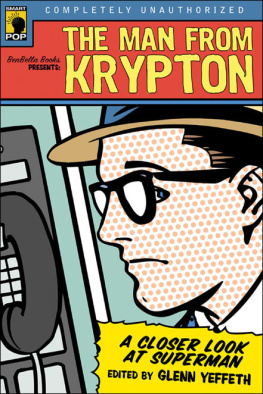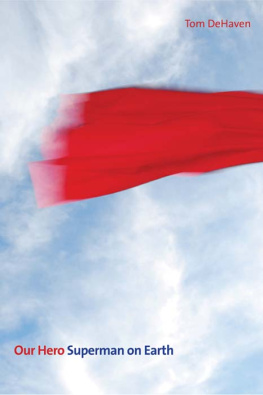
ALSO EDITED BY JOSEPH J. DAROWSKI
AND FROM MCFARLAND
The Ages of the Avengers: Essays on the Earths Mightiest Heroes in Changing Times (2014)
The Ages of the X-Men: Essays on the Children of the Atom in Changing Times (2014)
The Ages of Wonder Woman: Essays on the Amazon Princess in Changing Times (2014)
The Ages of Superman
Essays on the Man of Steel in Changing Times
Edited by JOSEPH J. DAROWSKI

McFarland & Company, Inc., Publishers
Jefferson, North Carolina
LIBRARY OF CONGRESS CATALOGUING DATA ARE AVAILABLE
BRITISH LIBRARY CATALOGUING DATA ARE AVAILABLE
e-ISBN: 978-0-7864-8964-0
2012 Joseph J. Darowski. All rights reserved
No part of this book may be reproduced or transmitted in any form or by any means, electronic or mechanical, including photocopying or recording, or by any information storage and retrieval system, without permission in writing from the publisher.
Front cover design by Rob Russell
Cover photograph 2012 iStockphoto
McFarland & Company, Inc., Publishers
Box 611, Jefferson, North Carolina 28640
www.mcfarlandpub.com
Preface
JOSEPH J. DAROWSKI
Some may consider Superman quaint or outdated. There are certainly edgier and grimmer characters that have been created. But Superman has had one of the most profound impacts on American popular culture of any fictional character and to this day he remains a profit-generator. First published in the early days of the comic book industry, the Man of Steel gave birth to the superhero genre. This genre, though most closely linked to the comic book medium where it began, has influenced all aspects of the entire entertainment industry. And it all began in 1938 when Superman, created by Jerry Siegel and Joe Shuster, first appeared on the cover of Action Comics #1 (Jun. 1938).
The elements of the superhero genre fully came together for the first time when Superman first appeared, and he was soon followed by Batman, Wonder Woman, and hundreds of others. Costumed superheroes are among of the defining figures of American entertainment, as iconically American as the Western cowboy. Superheroes, though always present in some form in our entertainment, have enjoyed a resurgence in popular culture in the last decade. At the same time that superheroes have been the stars of childrens cartoons and live-action dramas on television, dominated the Hollywood box office, and taken another troubled step onto Broadway stages, the academy has given greater notice to comic book superheroes. Numerous books have been published looking at individual creators, the history of the industry, or topics such as superheroes and philosophy or superheroes and religion. This book will attempt to do something different. It will explore the evolution of a popular culture icon, Superman, and how he has remained relevant for more than seven decades of uninterrupted narratives.
One of the most intriguing aspects of Superman is that new stories have been told featuring the character continually since his creation. While many other franchises of the entertainment industry, such as James Bond or Star Trek, have had new chapters added across a long period of time, there are often years in between the new stories being produced. Superman comics have been published continuously since 1938, with a new story, or even four or five or six new stories, appearing on a more-or-less monthly schedule. This long-running narrative allows for a fascinating look at the evolution of Superman.
While Superman from World War II era comic books is easily identified as the same character as the Superman of Cold War era comics, there are clear and obvious distinctions when they are looked at closely. By exploring how this popular culture icon has changed through the years we can track how our entertainment mirrors the changes in American society. Superman began as a crusading social avenger at the end of the Great Depression, became a patriotic hero during World War II, saw his powers increase in the early years of the Cold War, entered a period of flux during the Vietnam War, was killed and returned at the end of the Cold War, and has looked for his place in the superhero world since the turn of the century. Near the end of 2011 the character experienced yet another reimagining, this one a more serious break from his previous stories. This collection will analyze the character, primarily through his comic book adventures, in chronological order until this most recent reimagining of the Man of Steel. Stories from each decade of his existence will be analyzed in the context of society at that time. Our popular entertainment does not exist in a vacuum, and though it may serve as escapist fare it still reflects the real world.
The collection begins with Todd S. Munson examining the Superman comics from the World War II era in Superman Says You Can Slap a Jap!: The Man of Steel and Race Hatred in World War II. While the comic book stories themselves rarely touched on the war effort, Superman was an agent of American propaganda. Especially on comic book covers and adaptations into other media, Superman was frequently shown battling Americas enemies.
Lori Maguire and Peter Lee each look at Superman stories from the 1950s during the Cold War era. In Supervillains and Cold War Tensions in the 1950s, Maguire examines the villains Superman faced in relation to the fears that dominated American society at the time. Lee explores the relationship between Kryptonite and the nuclear age in Kryptonite, Radiation and the Birth of the Atomic Age.
Louie Dean Valencia Garca provides a different view of this American icon, by analyzing Supermans influence in Spain during the 1950s and 1960s. Truth, Justice, and the American Way in Francos Spain looks at translations of Superman comics at a period when Francisco Franco was attempting to control as much of Spains popular culture as possible. While Superman may often be seen as an unproblematic symbol of virtue in America, in Spain at this time the American ideals embedded in Superman comic books were considered radical and often censored. This alternative view of Superman allows for an understanding of how the American values Superman embodied could be perceived from different perspectives.
Thomas C. Donaldson and Christopher B. Zeichmann each look at Supermans supporting cast in comic books published in the 1970s. The characters experienced significant changes and revisions in apparent reaction to social movements in America. Donaldsons The Inflexible Girls of Steel: Lois Lane, Supergirl, and the Subversion of Second Wave Feminism explores the expanded Superman family in the context of the feminist movement. While in Black Like Lois: Confronting Racism, Configuring African American Presence Zeichmann looks at a story in which Lois Lane becomes African American for a day in relationship with the Black Power movement.
Jason M. LaTouche and Paul R. Kohl examine a story published during a time when DC Comics attempted to make their characters more relevant in relation to real-world events. In Red, White and Bruised: The Vietnam War and the Weakening of Superman LaTouche examines a Superman story arc called The Sandman Saga and uses the United States increasingly unpopular involvement in the Vietnam War as a means of interpreting the message. Kohl examines the same story in The Struggle Within: Supermans Difficult Transition into the Age of Relevace, but with a different societal parallel. Kohl uses the changing role of the news media and the counterculture movement as societal touchstones that inform the story. Both analyses are equally thorough and insightful.
Next page








